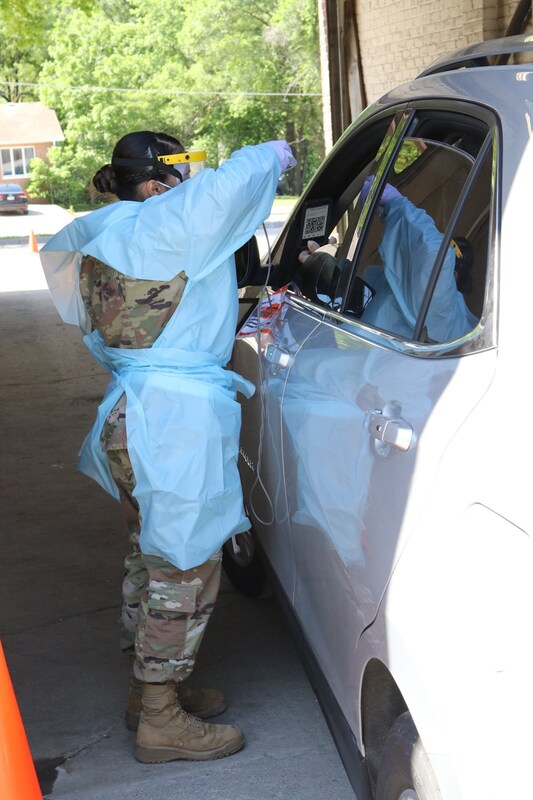Finding Participants
One of the researchers, a National Guard member herself, reached out to two colleagues and friends that were activated in response to the COVID-19 pandemic. These service members happened to be from two different states, Nebraska and Ohio, and were willing to ask their friends and colleagues on the COVID mission to participate in this ethnography project. Six total soldiers participated, three from each state. The main search criteria for participants was their assignment to their state's COVID testing force. No Military Occupational Specialty (MOS), rank, or age was targeted.
Methods
Two methods were used to collect information from the participants:
Survey Method:
A google form was created with a list of questions asking the soldiers about their experiences on the COVID mission. All soldiers had completed the mission at the time they responded to the questionnaire. All soldiers were told their answers would remain anonymous. They were also reminded to consider Operational Security (OPSEC), a Department of Defense process to protect critical information, in their responses to protect themselves and the researchers.
Demographic and organizational questions:
Interview Method:
The two soldiers that acted as points of contact from each state were chosen to participate in a zoom interview with one of the researchers. The interviewees answered the same google form questionnaire prior to interview. The researchers used their answers to the google forms questions to design an outlined interview, however they allowed for the soldiers to mostly explain what information they felt relevant to share. Most questions asked by the researchers were follow-ups to information provided by the soldiers. Both interviews lasted about an hour.
Survey Method:
A google form was created with a list of questions asking the soldiers about their experiences on the COVID mission. All soldiers had completed the mission at the time they responded to the questionnaire. All soldiers were told their answers would remain anonymous. They were also reminded to consider Operational Security (OPSEC), a Department of Defense process to protect critical information, in their responses to protect themselves and the researchers.
Demographic and organizational questions:
- Name (optional)
- Rank During Mission
- MOS? (Ex. 11B - Infantryman)
- What is your branch?
- What state do you drill out of?
- How long were you on the COVID mission?
- Please describe what your overall objective/task was?
- How did you feel about being a part of this mission?
- Do you feel like the mission you were on made an impact in public health control of COVID-19? Please explain.
- Did you feel that you had adequate personal protective equipment? Please explain what equipment you did and didn't have.
- Did you feel like you were provided enough medical supplies? Please explain.
- .Were there any health coverage concerns expressed to you by those you tested?
- How did those you tested seem to react to your presence? For example, were they grateful, scared, untrusting, annoyed? Please provide examples, especially of encounters that stood out to you.
- What system was in place, as told to you by your chain of command, to care for you and your family members if you were to contract COVID-19?
- Did you or anyone on the mission with you contract COVID-19? If so, please explain how it was handled.
- Where you informed about how many COVID positive patients you came into contact with?
- Is there is any part of your experience that you want to share that you haven't talked about yet? If so please tell. Your feelings about being on the mission, how it was handled, and COVID, in general, are of particular interest.
- Would you be willing to answer any follow-up questions about your responses?
Interview Method:
The two soldiers that acted as points of contact from each state were chosen to participate in a zoom interview with one of the researchers. The interviewees answered the same google form questionnaire prior to interview. The researchers used their answers to the google forms questions to design an outlined interview, however they allowed for the soldiers to mostly explain what information they felt relevant to share. Most questions asked by the researchers were follow-ups to information provided by the soldiers. Both interviews lasted about an hour.
Limitations
- The study was limited to lower enlisted individuals that were not completely aware of the upper-level communication and decision making that was occurring. Many of the issues that will be discusses later may be explained away if the study had access to higher ranking and more decision making involved individuals.
- Background data was extremely difficult to collect and find on the National Guard missions and their collaboration with the public health departments of each state. For example, no clear information on contact tracing could be found at all and no information on National Guard COVID rates (though this may be due to the fact that there hasn't been much testing).
- Not all state National Guard responses could be compared and there is a lot of missing data about the entirety of the US COVID response because of this. Instead, the states of Ohio and Nebraska must be used as middle ground proxies for the country's response as a whole.

